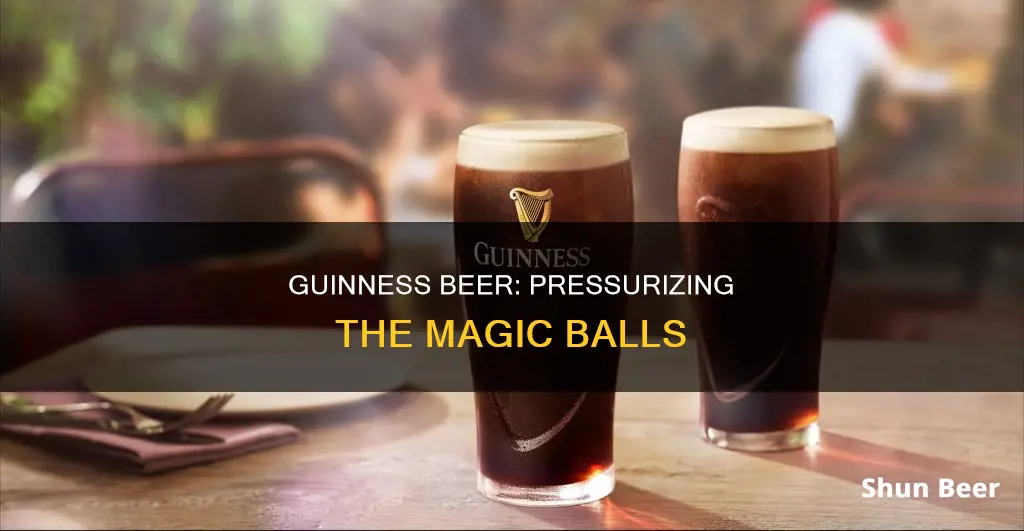
The ball in Guinness beer is actually called a widget, and it's there to make your beer taste better. During the canning process, brewers add liquid nitrogen to the beer, which quickly evaporates and creates pressure inside the can. This pressure forces gas and liquid into the widget through its tiny hole. When you open the can, the pressure drops and the nitrogenated beer inside the widget is released, creating a burst of tiny bubbles that give Guinness its iconic thick, creamy head.
| Characteristics | Values |
|---|---|
| Name of the ball | Widget |
| Material | Food-grade plastic |
| Shape | Hollow sphere |
| Size | Similar to a ping pong ball |
| Function | Replicates the draught experience in a can |
| How it works | Pressurized nitrogen is added to the brew during canning, which trickles into the widget's hole along with a little bit of beer. The entire can is then pressurized. When the can is opened, the pressure inside drops, and the nitrogenated beer squirts out of the widget, creating a burst of tiny bubbles that rise to the top of the beer. |
What You'll Learn
- The widget is a hollow plastic ball with a small hole
- Brewers add liquid nitrogen to Guinness during canning
- The nitrogen evaporates, creating pressure inside the can
- When the can is opened, the pressure drops and the widget releases nitrogen?
- This creates a thick, creamy head, like a freshly poured draught Guinness

The widget is a hollow plastic ball with a small hole
The widget is a hollow plastic ball, similar in appearance to a ping pong ball, with a small hole. It was developed by Guinness in 1969 to give their canned beers a creamy, silky head. During the canning process, brewers add liquid nitrogen to the beer before sealing the can. This liquid nitrogen quickly evaporates, creating pressure inside the can. This pressure forces gas and liquid into the widget through its small hole. When the can is opened, the pressure inside the can drops to equalise with the room's pressure. However, the pressure inside the widget remains higher than the surrounding beer due to the tiny hole, allowing gas to escape. This pressure difference causes the nitrogenated beer inside the widget to squirt into the beer, creating a burst of tiny nitrogen bubbles that rise to the top, forming a thick, creamy head.
The widget's function is to make canned Guinness taste as fresh as a draught beer poured from a tap. The nitrogen bubbles created by the widget are smaller than carbon dioxide bubbles, resulting in a smoother and more delicate head and taste. Additionally, the fleeting nature of nitrogen gas in liquid makes it challenging to maintain desired levels in packaged beers once opened, and the widget helps address this issue.
The first-generation widget, released in 1989, was a flattened disc that worked well with cold beer but caused overflow when the beer was warm. In 1997, Guinness introduced the floating, spherical widget seen in cans today, known as the "Smoothifier," to resolve this issue.
The widget has been recognised as a significant innovation, voted as one of the greatest inventions of the 20th century by British people in a 2004 survey, even beating out the internet.
The Irish Pride: Guinness Beer's Roots and Heritage
You may want to see also

Brewers add liquid nitrogen to Guinness during canning
The "widget" in Guinness beer cans is a hollow, spherical piece of food-grade plastic with a tiny hole in it. It was developed by Guinness in 1969 to give their canned brews a silky, creamy head. During the canning process, brewers add liquid nitrogen to the beer immediately before sealing it. The liquid nitrogen quickly evaporates and creates pressure inside the can. This forces gas and liquid into the widget through its tiny hole.
When the can is opened, the pressure inside drops to equalize with the room's pressure. However, the pressure inside the widget remains higher than the surrounding beer, causing the nitrogenated beer to squirt out of the widget and mix with the rest of the beer. This creates the foamy head that is iconic to a pint of Guinness.
The widget was designed to make canned Guinness taste like it was just poured fresh from the tap. Guinness released its first-generation widget in 1989, which was a flattened disc that sat at the bottom of the can. This worked well when the beer was served cold, but if the beer was warm, it could overflow once the can was opened. In 1997, Guinness released the floating, spherical widget found in cans today, which they call the "smoothifier."
Nitrogen bubbles are smaller than carbon dioxide bubbles, resulting in a smoother and more delicate head and taste. Nitrogen is also more stable, so more bubbles remain intact when the beer is opened. This gives Guinness its thicker, more velvety "mouthfeel" without the acidic bite of carbonation.
Guinness Beer and Caffeine: What's the Connection?
You may want to see also

The nitrogen evaporates, creating pressure inside the can
The "widget" in Guinness beer cans is a hollow, spherical piece of food-grade plastic with a tiny hole in it. It was developed by Guinness in 1969 to give their canned brews a silky, creamy head. During the canning process, brewers add liquid nitrogen to the beer immediately before sealing it. The liquid nitrogen quickly evaporates inside the can. However, since the can is sealed, this creates pressure inside it.
Nitrogen is used to give Guinness its distinctive sweet and silky taste and mouthfeel. Nitrogen bubbles are smaller than CO2 bubbles, so the resulting head and taste are smoother and more delicate. The nitrogen also gives the brew a thicker, more velvety "mouthfeel" without the acidic bite of carbonation with CO2.
Because of the fleeting nature of nitrogen gas in liquid, it's challenging to maintain desirable levels of the gas in packaged beers once they are opened. This is where the widget comes in. The pressure forces gas and liquid into the widget through its tiny hole.
When the can is opened, the pressure inside drops to equalize with the room's pressure. However, the pressure inside the widget remains higher than the pressure in the beer.
Guinness Beer: Heartworm Killer or Old Wives' Tale?
You may want to see also

When the can is opened, the pressure drops and the widget releases nitrogen
The "widget" is a hollow, spherical piece of food-grade plastic with a tiny hole in it, resembling a ping pong ball. During the canning process, brewers add liquid nitrogen to the beer immediately before sealing the can. The liquid nitrogen quickly evaporates, but since the can is sealed, this creates pressure inside it. This forces gas and liquid into the widget through its tiny hole.
When the can is opened, the pressure inside the can drops to equalise with the room's pressure. However, the pressure inside the widget remains higher than the pressure in the beer around it. This is due to the tiny hole, which allows gas to escape. This pressure difference causes the nitrogen inside the widget to squirt into the beer, creating a burst of tiny nitrogen bubbles that rise to the top of the beer. This results in a thick, creamy head similar to what you would get from a freshly poured draught Guinness.
The widget was developed by Guinness in 1969 to give their canned beers a silky, creamy head. The first-generation widget was released in 1989 and was a flattened disc that sat at the bottom of the can. This widget worked well when the beer was served cold, but if the beer was warm, it could overflow or explode after opening. To fix this problem, Guinness released the floating, spherical widget in 1997, which they call the "Smoothifier".
The use of nitrogen instead of carbon dioxide gives Guinness its distinctive sweet, silky taste. Nitrogen bubbles are smaller than carbon dioxide bubbles, resulting in a smoother and more delicate head and taste. Nitrogen gas also doesn't easily dissolve in water, so when you open a beer, most of the gas is released into the air, but the foamy bubbles in the head remain. This, along with the smaller bubbles, gives Guinness its signature thick, velvety "mouthfeel" without the acidic bite of carbonation.
Guinness Beer: Perfect Pairing Ideas for a Hearty Pint
You may want to see also

This creates a thick, creamy head, like a freshly poured draught Guinness
The "widget" in Guinness beer cans and bottles is a hollow, spherical piece of food-grade plastic with a tiny hole in it, resembling a ping pong ball. During the canning process, brewers add liquid nitrogen to the beer immediately before sealing it. The liquid nitrogen quickly evaporates, creating pressure inside the can. This forces gas and liquid into the widget, and the can is then pressurised.
When the can is opened, the pressure inside drops to equalise with the room's pressure. However, the pressure inside the widget remains higher than the pressure in the beer. So, when the can is opened, the gas and liquid leave the widget and mix with the beer, creating a foamy head. This process is what gives Guinness its thick, creamy head, like a freshly poured draught.
The widget was developed by Guinness in 1969 to give their canned beers a silky, creamy head. The first-generation widget was released in 1989, but it had a tendency to overflow when the beer was served warm. In 1997, Guinness released the floating, spherical widget, which they call the "smoothifier", to fix this issue.
Nitrogen bubbles are smaller than carbon dioxide bubbles, so the resulting head and taste are smoother and more delicate. Because of the fleeting nature of nitrogen gas in liquid, it's challenging to maintain tasty levels of the gas in packaged beers once they're opened. The widget helps with this by slowly releasing nitrogen into the beer when it's opened.
Guinness Beer in Hawaii: Where to Find It
You may want to see also
Frequently asked questions
The ball in Guinness beer cans is called a widget. It is a hollow, spherical piece of food-grade plastic with a tiny hole in it.
During the canning process, brewers add liquid nitrogen to the beer immediately before sealing it. The liquid nitrogen quickly evaporates, creating pressure inside the can. This forces gas and liquid into the widget through its tiny hole.
Guinness uses the widget to create a creamy head on the beer, giving it a smoother and more delicate taste.







